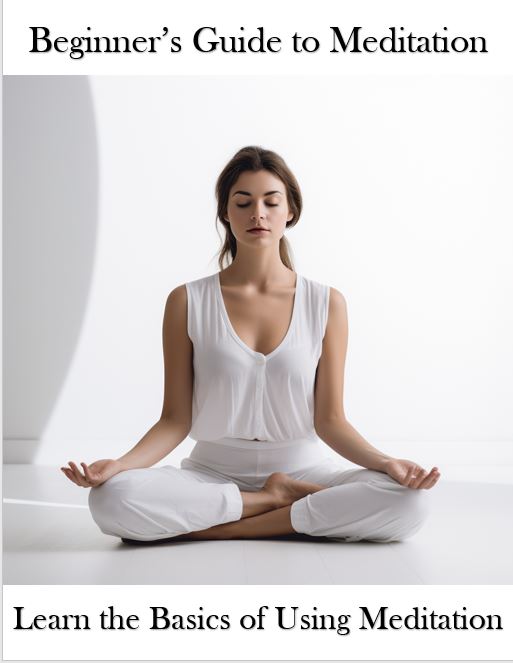Guided Meditation for Beginners: Complete Step-by-Step Beginner’s Guide
Begin your meditation journey today. Learn how to start guided meditation for beginners, explore benefits, find the best apps, and build a peaceful routine.

Guided meditation is one of the simplest and most approachable ways to begin a meditation practice. Instead of figuring it out on your own, you listen to a calm, instructive voice that takes you through easy steps—such as breathing deeply, relaxing your muscles, or imagining soothing images like a peaceful beach or a quiet forest.
The best part? You don’t need special equipment, prior experience, or long stretches of time. Just a few minutes in a quiet space and an open mind are enough to get started.
Research from institutions like Harvard Medical School has found that even short, consistent meditation sessions can help lower stress, improve emotional balance, and support overall mental health. Over time, guided meditation can also enhance your focus, improve sleep quality, and contribute to a greater sense of inner calm.
➤ In this article, we’ll explore how beginners can get started with guided meditation, what benefits to expect, and how to create a simple, sustainable routine that fits easily into daily life.
What Is Guided Meditation?

Image source: i.pinimg.com
Guided meditation is a form of meditation in which a narrator, teacher, or audio guide gently leads you through the practice step by step. Instead of sitting in silence and trying to figure out what to do, you receive clear instructions—such as when to focus on your breath, how to relax different parts of your body, or where to direct your attention.
These sessions often include:
-
Breathing cues to steady your breath and calm your nervous system.
-
Mindfulness prompts to bring awareness to thoughts, sensations, or emotions without judgment.
-
Visualization exercises that encourage mental imagery for relaxation or focus.
Beginners often find guided meditation especially helpful because it removes the uncertainty about “doing it right.” You can follow along with a recording, app, or live teacher, making it easier to stay present and engaged.
According to the National Center for Complementary and Integrative Health (NCCIH), guided meditation has been linked to benefits such as stress reduction, improved emotional well-being, and better self-awareness. Over time, it can also support mental clarity and resilience.
In short, guided meditation acts like training wheels for the mind—it provides structure, guidance, and reassurance, making meditation more approachable for newcomers and deeply relaxing even for experienced practitioners.
If you’d like to dive deeper into how mental and emotional health differ—and why both matter for overall well-being—check out our complete guide on The Difference Between Mental and Emotional Health.
Why Guided Meditation Helps Beginners

Image source: simplyloveplr.com
Starting meditation can feel overwhelming—many beginners struggle with restlessness, wandering thoughts, or simply not knowing what to do. This is where guided meditation becomes especially helpful.
Clear Direction and Structure
In guided sessions, an instructor (through audio or video) gently leads you step by step—whether it’s focusing on the breath, doing a body scan, or practicing visualization. This structure removes the pressure of figuring it out alone, which makes it easier to settle into the practice.
An Anchor for Your Attention
The guide’s voice acts as a steady anchor, gently bringing your focus back whenever your mind drifts. This is particularly valuable in the early stages, when distraction is common.
Backed by Research
Scientific studies support the benefits. Research in journals like Mindfulness and Frontiers in Psychology has shown that guided meditation can:
-
Improve focus and sustained attention
-
Reduce stress and anxiety
-
Enhance emotional regulation
For beginners, this means faster progress and a more positive first experience with meditation.
Building Independence Over Time
While guided meditation is a supportive starting point, it also lays the foundation for independent practice. As you grow more comfortable, you’ll learn techniques that can eventually be practiced without guidance. Many meditators move naturally from guided to self-led sessions, gaining confidence along the way.
In short: Guided meditation offers beginners a smooth learning curve, combining expert direction, scientific benefits, and a supportive environment for building long-term meditation habits.
Common Benefits of Guided Meditation

Image source: i.pinimg.com
Guided meditation has become one of the most accessible ways for beginners and experienced practitioners alike to experience the benefits of mindfulness. Research shows that regular practice can reduce stress, lower anxiety levels, and improve overall emotional well-being. Many people also report better sleep quality, greater focus, and a calmer response to daily challenges.
According to the Mayo Clinic, meditation may also play a supportive role in managing certain health concerns, including high blood pressure, tension headaches, and stress-related symptoms. While benefits vary from person to person, studies suggest that noticeable improvements often emerge after a few weeks of consistent practice.
One of the biggest advantages of guided meditation—especially for beginners—is that it removes much of the guesswork. Instead of struggling with silence or wondering “Am I doing this right?”, you’re gently led by a teacher’s voice, background music, or visualizations. This structured approach helps build a steady habit, making it easier to integrate mindfulness into everyday life.
How to Start Guided Meditation for Beginners
Image source: encrypted-tbn0.gstatic.com
Starting guided meditation doesn’t need to be overwhelming—it’s actually one of the easiest ways to begin meditating. With the help of a recorded guide, you’ll simply follow instructions that gently lead you through breathing, relaxation, and focus techniques.
Step 1: Create the Right Environment
Choose a calm, quiet space where you won’t be disturbed. This could be your bedroom, a cozy corner, or even your car parked somewhere peaceful. The idea is to limit distractions.
Step 2: Get Comfortable
Sit upright in a chair with your feet flat on the ground, or lie down on a yoga mat or bed. Comfort matters, but try to stay alert enough not to fall asleep.
Step 3: Pick a Beginner-Friendly Session
Apps like Headspace, Calm, and Insight Timer offer free and paid guided meditations designed for beginners. You can also find excellent options on YouTube by searching for “guided meditation for beginners 5–10 minutes”. Starting small helps you stay consistent.
Step 4: Use Headphones (Optional but Helpful)
Headphones can improve focus by blocking out background noise and making the guide’s voice clearer.
Step 5: Follow the Voice
Simply listen and follow along. You’ll often be guided to focus on your breath, notice body sensations, or gently bring your attention back when your mind wanders.
Quick Start Checklist
-
Find a quiet, distraction-free space
-
Sit or lie down comfortably
-
Choose a 5–10 minute guided session (short and doable)
-
Use headphones if possible
-
Follow the guide’s voice step by step
-
Be kind to yourself—wandering thoughts are normal
Pro Tip: Consistency matters more than length. Even 5 minutes daily can build focus, reduce stress, and help you develop a lasting meditation habit.
If you’re looking for spiritual strength to support your well-being, don’t miss our guide on Prayer for Mental Health: 12 Powerful Prayers, Scriptures & Guidance for Emotional Healing
Best Time of Day to Meditate

Image source: jessexplainsitall.com
There isn’t a single “perfect” time to meditate that works for everyone. Instead, the best time is the one that fits naturally into your routine and feels sustainable. Different times of day offer unique benefits:
-
Morning Meditation – Practicing shortly after waking can set a calm, focused tone for the rest of your day. It may also be easier to build consistency before the busyness of daily tasks begins.
-
Midday or Lunch Break Meditation – Taking even 5–10 minutes in the middle of your day can help reduce stress, improve concentration, and recharge your energy for the afternoon.
-
Evening Meditation – Reflecting or practicing mindfulness at night can promote relaxation, help release the day’s tension, and support better sleep.
According to experts at the Cleveland Clinic, the most effective time is the one you’re most likely to practice regularly. What matters more than the clock is consistency—whether that means starting your morning with mindfulness, pausing during work, or winding down before bed.
Tip: Experiment with different times of day for a week each, then notice when meditation feels most natural and impactful for you. Once you find that sweet spot, commit to making it part of your daily rhythm.
How Long Should Beginners Meditate?

Image source: images.everydayhealth.com
If you’re new to meditation, the key isn’t about sitting for hours—it’s about building consistency. Starting small makes it easier to form a lasting habit without feeling overwhelmed.
For most beginners, 3 to 5 minutes a day is a great place to start. This short practice is long enough to calm your mind but not so long that it feels intimidating. As you get more comfortable, you can gradually extend your sessions to 10 or 15 minutes.
Research backs this up: even brief daily meditation can bring real benefits. For instance, studies show that as little as 10 minutes of mindfulness meditation can improve focus, reduce stress, and boost emotional well-being. What matters most is not how long you meditate, but how consistently you return to your practice.
Pro Tip: Pick the same time each day—like right after waking up or before bed—to anchor the habit. Short, regular sessions are far more effective than long, occasional ones.
What You Need to Get Started

Image source: community.thriveglobal.com
You don’t need any expensive equipment or a special meditation cushion to begin. A quiet spot, your smartphone, and maybe a pair of headphones (if you prefer) are enough. To make the experience more enjoyable, you can add small touches—like soft lighting or a calming scent such as lavender.
The key is to minimize distractions: silence notifications, let others know you’ll be unavailable for a short while, and choose a time when interruptions are less likely. Keeping your setup simple and consistent helps you ease into practice without overthinking it.
Tip: Many beginners find it useful to designate a small “practice corner” in their home. Over time, this spot becomes a gentle cue for your mind to settle and focus.
If you’re looking for a calming and creative self-care activity, check out our guide on Coloring Pages for Mental Health: Benefits, Best Designs & How to Use.
Apps That Offer Guided Meditation for Beginners

Image source: i.pinimg.com
If you’re just starting your meditation journey, choosing the right app can make a huge difference. The following platforms are well-known for their user-friendly approach, beginner-friendly content, and helpful features:
1. Headspace
Headspace is one of the most popular meditation apps worldwide. It offers a structured beginner’s course that teaches meditation basics step by step, using fun animated guides to explain complex ideas in a simple way. You’ll also find themed sessions for stress, focus, and better sleep.
2. Calm
Calm combines meditation with a holistic wellness experience. Beyond guided sessions, it features nature sounds, music for relaxation, breathing exercises, and bedtime stories (read by celebrities like Matthew McConaughey) to help improve sleep quality. Its programs are especially helpful if your main goal is stress reduction or better rest.
3. Insight Timer
Known as the world’s largest free meditation library, Insight Timer gives you access to over 150,000 guided meditations from teachers across the globe. You can also join live events, follow specific teachers, or use the customizable meditation timer for unguided practice. It’s ideal if you want variety and flexibility without paying for premium apps.
4. Simple Habit
Built for busy lifestyles, Simple Habit specializes in short, 5–10 minute sessions designed for on-the-go mindfulness. Whether you’re commuting, taking a break at work, or winding down after a hectic day, it offers quick meditations that fit into any schedule.
Extra Features to Consider
Most of these apps include:
-
Progress tracking to build a consistent habit.
-
Voice and teacher options so you can choose the style that resonates with you.
-
Personalized recommendations based on your goals (e.g., stress relief, focus, sleep).
Since each app has a different feel and teaching style, it’s best to try a few free versions first before committing to a subscription. This way, you’ll discover which voices, techniques, and interfaces make you feel the most comfortable.
Pro Tip: If you’re completely new, start with Headspace’s basics course or Calm’s beginner series. If you want more freedom without cost, Insight Timer is your best bet.
Types of Guided Meditation Styles

Image source: positivezenenergy.com
If you’re new to meditation, experimenting with different styles can help you discover what resonates best. Each approach has its own benefits, making it easier to choose based on your personal goals—whether that’s reducing stress, improving focus, or cultivating compassion. Here are some of the most popular styles:
1. Body Scan Meditation
This practice involves slowly directing your attention through different parts of the body, usually starting from the feet and moving upward. It helps you notice areas of tension, release stress, and develop greater body awareness. Body scans are especially effective for relaxation and winding down before sleep.
2. Mindfulness Meditation
Mindfulness is about paying attention to the present moment without judgment. In guided sessions, you may focus on your breath, sounds, or sensations while letting go of distractions. This style is widely studied for its benefits in reducing anxiety, improving concentration, and increasing emotional resilience.
3. Visualization Meditation
Also called guided imagery, this style uses mental pictures—such as walking through a peaceful forest or imagining healing light—to calm the mind and body. Visualization can reduce stress, boost positivity, and even support performance in sports or creative work by engaging the imagination.
4. Loving-Kindness Meditation (Metta)
Metta meditation centers on generating feelings of compassion and goodwill toward yourself and others. A guide typically leads you through phrases like “May I be happy, may I be healthy,” gradually extending these wishes to loved ones, acquaintances, and eventually all beings. Regular practice can increase empathy, reduce anger, and strengthen social connections.
If you’re looking for more nourishing meal ideas that are easy to eat and packed with protein, check out our guide on High Protein Pureed Food Recipes: Easy, Nutritious Meals for Recovery & Wellness
Comparing Types of Guided Meditation
Image source: encrypted-tbn0.gstatic.com
|
Meditation Type |
Best For |
Typical Duration |
Key Features & Benefits |
|
Body Scan |
Stress relief, sleep improvement, easing tension |
5–30 minutes |
Step-by-step attention to each part of the body, promoting deep relaxation and awareness of physical sensations. Often used before bed or during stress recovery. |
|
Mindfulness |
Focus, everyday calm, emotional balance |
10–20 minutes |
Focuses on the breath, thoughts, and present-moment awareness. Builds mental clarity, reduces distraction, and is widely used in clinical stress-reduction programs. |
|
Loving-Kindness (Metta) |
Compassion, forgiveness, emotional healing |
10–30 minutes |
Repetition of compassionate phrases toward self and others. Enhances empathy, reduces negative emotions, and supports better social connection. |
|
Visualization |
Relaxation, creativity, motivation |
5–15 minutes |
Uses guided imagery—such as imagining peaceful scenes or successful outcomes—to boost creativity, calmness, and goal-setting focus. |
Source: Adapted from Harvard Health Publishing, Calm App Catalogs, and NCCIH (2024–2025).
Guided Meditation and Sleep

Image source: i.ytimg.com
If falling asleep feels like a nightly struggle, guided meditation could be a gentle solution. These practices work by calming the nervous system, easing muscle tension, and quieting mental chatter that often keeps us awake.
Apps like Calm and Headspace offer structured sleep programs—such as Calm’s “7 Days of Sleep”—that use techniques like breathing cues, body scans, and progressive muscle relaxation. These methods help your body transition from a state of alertness to restfulness.
Research from the Sleep Foundation suggests that guided audio meditations at bedtime can improve both sleep quality and the time it takes to fall asleep. In other words, instead of tossing and turning, you may find yourself drifting off more naturally.
Tip: Try pairing meditation with other good sleep habits, like limiting screen time before bed and keeping your bedroom cool and dark, for the best results.
Meditation and Stress Relief

Image source: i0.wp.com
Meditation is one of the most effective, research-backed tools for reducing stress and promoting emotional balance. According to the American Psychological Association (APA), mindfulness practices such as guided meditation can help lower cortisol—the body’s primary stress hormone—while also improving overall resilience to daily challenges.
Guided meditation sessions designed for stress relief often combine several elements:
-
Body awareness – helping you notice areas of tension and consciously relax them.
-
Calming affirmations or phrases – creating a sense of emotional stability.
-
Breath control – slower, deeper breathing that activates the parasympathetic nervous system, shifting your body into a calmer state.
Regular practice doesn’t just provide short-term relief. Over time, meditation can improve focus, regulate mood, and even support better sleep—making it a valuable long-term strategy for managing stress in a busy lifestyle.
Meditation for Kids and Teens

Image source: cdn-abgke.nitrocdn.com
Mindfulness isn’t just for adults—kids and teens can benefit just as much, if not more, from developing these skills early on. Research shows that mindfulness practices help young people improve focus, emotional regulation, and overall well-being.
Why It Works
A 2021 review published in JAMA Pediatrics found that mindfulness training in children and adolescents was associated with better attention, reduced stress, and lower anxiety levels. These practices can also promote healthier sleep patterns and encourage emotional resilience during developmental years.
Practical Ways to Introduce Meditation
-
For younger children (ages 4–10): Short, story-based or guided bedtime meditations—offered by apps like Moshi or Smiling Mind—can make winding down at night easier and less stressful.
-
For pre-teens and teens: More structured mindfulness sessions, like those found on Headspace for Kids, can help them cope with academic pressure, screen fatigue, and social challenges. Breathing exercises and short “mind breaks” between study sessions can also enhance concentration.
Building a Routine
Consistency matters more than duration. Even 5–10 minutes a day can make a noticeable difference over time. Parents can join in, turning meditation into a shared activity that strengthens family bonds.
Key Takeaway
Mindfulness and meditation aren’t about forcing stillness—they’re about teaching kids and teens simple, practical tools to manage their minds and emotions. By starting early, they develop lifelong skills for stress management, focus, and self-awareness.
If you’re looking for Bible verses to bring comfort and protection while you travel, don’t miss our guide on Scriptures for a Safe Journey: Travel with God’s Promises
Meditation for Anxiety and Emotions

Image source: i0.wp.com
When anxiety feels overwhelming, meditation can offer a safe and grounding mental space. Guided practices, in particular, are effective because they provide structure and reassurance, making it easier to stay present.
Why It Works
Research highlighted by the Anxiety & Depression Association of America (ADAA) shows that mindfulness-based meditation helps reduce repetitive anxious thoughts and improves emotional regulation. By training the mind to notice and release worry, meditation fosters calm and clarity.
Techniques That Help
-
Breath Awareness: Focusing on slow, steady breathing signals the nervous system to relax.
-
Grounding Practices: Bringing attention to the body or environment reduces racing thoughts and restores a sense of safety.
-
Affirmations & Visualization: Gentle reminders like “I am safe” or visualizing a calming place can soothe emotional intensity.
Choosing a Guided Meditation
Look for recordings or apps with themes designed for anxiety relief, such as:
-
“Letting Go” – encourages release of tension and intrusive thoughts.
-
“Safe Place” – helps create a mental sanctuary when emotions feel overwhelming.
-
“Self-Compassion” – promotes kindness toward yourself, reducing harsh self-criticism.
Many people find that even 5–10 minutes a day of meditation can significantly reduce stress and improve resilience over time.
Creating a Meditation Routine

Image source: www.yogabasics.com
Building a consistent meditation practice is easier when you connect it to habits you already do every day. For example, try meditating right after brushing your teeth in the morning or just before lunch. This technique, known as habit stacking, helps anchor your new routine to an existing behavior, making it more likely to stick.
To strengthen your commitment, set recurring reminders on your phone or use habit-tracking apps that celebrate your progress. Many people also find it helpful to keep a simple journal—just a few lines about how each session felt or what thoughts came up. Over time, this reflection shows how your practice is evolving and keeps you motivated.
Research on behavior change suggests that habits are more sustainable when tied to consistent cues and daily patterns. That’s why guided meditations for beginners often feel easier once they become part of your lifestyle—like a natural pause in your day rather than another task on your to-do list.
How to Stay Focused During Meditation

Image source: i0.wp.com
It’s completely natural for your mind to wander while meditating—especially if you’re just starting out. Instead of getting frustrated, treat distractions as part of the process. The key is to gently guide your attention back—whether to your breath, a mantra, or the guidance you’re following.
Think of it like strength training for the mind: each time you notice your focus drifting and bring it back, you’re building mental resilience and clarity. Over time, this repeated “returning” strengthens your concentration, making it easier to stay present both in meditation and in daily life.
Even experienced meditators lose focus sometimes. The difference is that they don’t see it as failure—just another chance to practice awareness. Remember: the real progress lies not in never getting distracted, but in how often and how kindly you return.
If you love saving money while making your trips more enjoyable, don’t miss our guide on Hotel Travel Tweaks: 21 Smart Hacks to Upgrade Your Stay & Save Big in 2025.
Choosing the Right Voice and Style
Image source: encrypted-tbn0.gstatic.com
The way a guide sounds can shape your entire experience. Some people feel more relaxed with a calm, soothing female voice, while others prefer a confident male tone. Similarly, background music can either enhance focus or become distracting—so it’s worth experimenting with silence versus soft melodies.
Most apps give you options to preview voices, adjust pacing, or filter by style before you commit. Take advantage of these tools to find a combination that resonates with you. The more comfortable you feel with the voice and delivery style, the easier it becomes to stay consistent and build a lasting habit.
Pro tip: Don’t settle too quickly. Try a few different tones and speeds across multiple sessions. What feels slightly unusual at first may end up being the perfect fit once you’ve given it time.
Realistic Expectations for Beginners

Image source: rivendellshop.co.nz
Meditation is not about achieving instant calm—it’s about developing a skill that unfolds gradually. Just like learning a musical instrument or building strength at the gym, progress takes time. Some days your mind may settle easily, while on others it might wander restlessly. Both experiences are completely normal.
Instead of aiming for perfection, focus on small, consistent wins. Sitting for five minutes, noticing even a single deep breath, or simply showing up for your practice are meaningful steps forward.
Research from UCLA’s Mindful Awareness Research Center highlights that meditation works cumulatively—the benefits build over time. You may not notice dramatic changes after a single session, but with regular practice you’ll likely experience reduced stress, better focus, and greater emotional resilience.
Remember: progress isn’t linear. What matters most is consistency, patience, and a willingness to return to your practice—no matter how it feels on a given day.
Most Popular Meditation Apps in the U.S. (2025)

Image source: media.post.rvohealth.io
Here’s an engaging snapshot of today’s most notable meditation apps—renowned for their features, content, and user appeal—rather than hypothetical usage figures.
1. Insight Timer — Best Free Content & Variety
Why it stands out: Boasting over 150,000 free guided meditations, Insight Timer stands unrivaled when it comes to generous free offerings paired with community interaction and flexible filtering by topic and duration.
2. Headspace — Best for Beginners & Habit-Builders
Why it's popular: Known for its structured, beginner-friendly courses, bite-sized meditation sessions, and habit-forming design, Headspace offers both guided meditation and newer expanded services like mental health coaching and virtual reality experiences. It's trusted globally, with more than 70 million users across 190 countries.
3. Calm — Best for Sleep-Focused Relaxation
Why users love it: Calm excels with its soothing sleep stories, serene soundscapes, and stress-reducing meditations—ideal for bedtime or winding down. Its content is delivered with a calming, high-production polish.
4. Simple Habit — Best for Quick, On-the-Go Meditation
Why it's useful: Crafted for fast-paced lives, Simple Habit provides short, accessible meditations that you can fit into commutes, breaks, or brief moments of calm—a great option for busy people.
(User numbers and ratings for Simple Habit weren’t confirmed in recent sources, so we’re spotlighting its strength in flexibility and convenience instead.)
Summary Table (Revised & More Accurate)
|
App |
What Makes It Special |
|
Insight Timer |
Largest free meditation library + community features |
|
Headspace |
Structured, beginner-friendly, expanding into wellness tech |
|
Calm |
Premiere app for sleep, relaxation, and immersive audio |
|
Simple Habit |
Quick, portable sessions perfect for busy schedules |
Why These Apps Matter in 2025
-
Insight Timer empowers users with a vast free collection and filtering tools to personalize their practice—even builds community support.
-
Headspace continues to evolve—adding VR experiences, coaching, and combining therapy services with guided mindfulness. It's scientifically backed and globally sprawling with a loyal user base.
-
Calm leans into restful, relaxing experiences, especially for better sleep—curating soundscapes, narrated stories, and ambient environments.
-
Simple Habit, with its fast-paced sessions and approachable interface, remains a go-to for users seeking straightforward, consistent meditation—even though newer usage stats aren’t available.
If you’re exploring premium corporate getaways, don’t miss our in-depth guide on Luxury Business Retreats: Destinations, Planning & Trends for 2025, where we break down the top locations, planning strategies, and emerging trends shaping executive retreats this year
Conclusion
Guided meditation for beginners is a gentle and accessible way to step into the world of mindfulness. You don’t need prior experience, expensive tools, or hours of free time—just a little curiosity and a few quiet minutes each day. Starting small is key: even 5–10 minutes of daily practice can create noticeable shifts in your focus, emotional balance, and overall sense of calm.
As you explore, try different styles—whether it’s breath awareness, body scans, or visualizations—to discover which approach resonates most with you. Many beginners also benefit from listening to guided audio sessions or using meditation apps, as these provide structure and encouragement.
With consistency, the benefits often extend beyond meditation itself, showing up in everyday moments—helping you handle stress more calmly, improve concentration, and feel more grounded. Remember, mindfulness is not about perfection; it’s about presence. Trust the process, be patient with yourself, and allow meditation to become a natural and enjoyable part of your daily routine.
FAQs
What is guided meditation for beginners?
Guided meditation for beginners is an audio-based or instructor-led session where someone gently walks you through breathing, visualization, or mindfulness steps to help you meditate effectively, even without prior experience.
How often should I do guided meditation?
Experts recommend practicing guided meditation 3–5 times per week. Daily practice offers the most benefits for focus, mood, and overall well-being.
Do I need any special equipment?
No special equipment is needed. A phone or speaker and a quiet place are enough. Headphones can enhance the experience by blocking out background noise.
Can guided meditation help with stress and anxiety?
Yes, numerous studies—including from the NIH and ADAA—support the use of guided meditation to reduce anxiety, calm the nervous system, and promote mental clarity.
Is guided meditation better than regular meditation?
Guided meditation is ideal for beginners because it offers structure and support. Over time, you may transition to unguided or silent meditation as you gain confidence.

 Selina Smith
Selina Smith 













